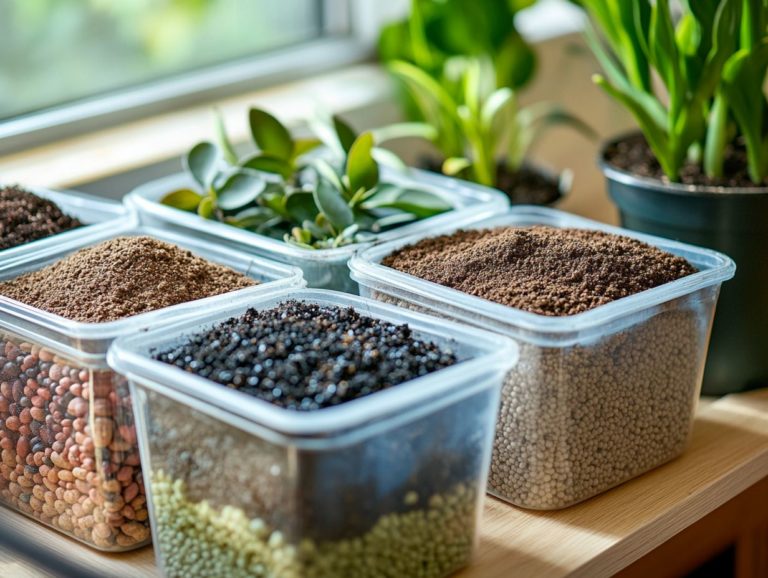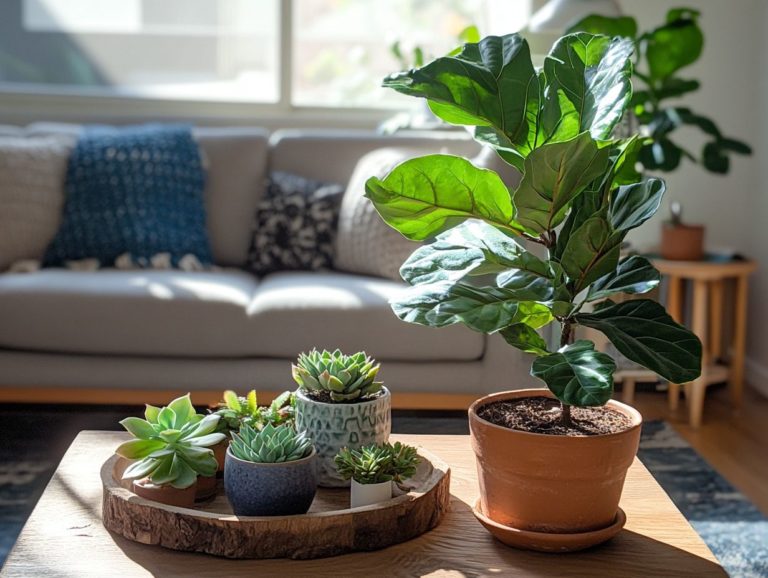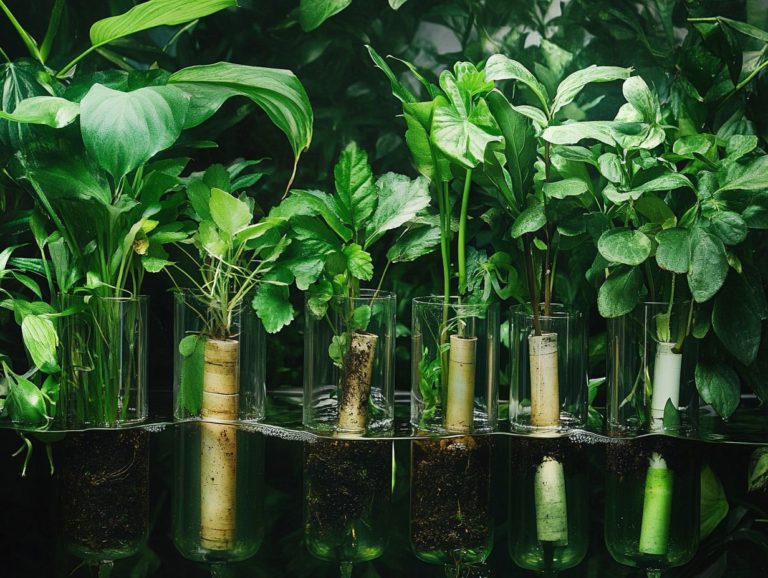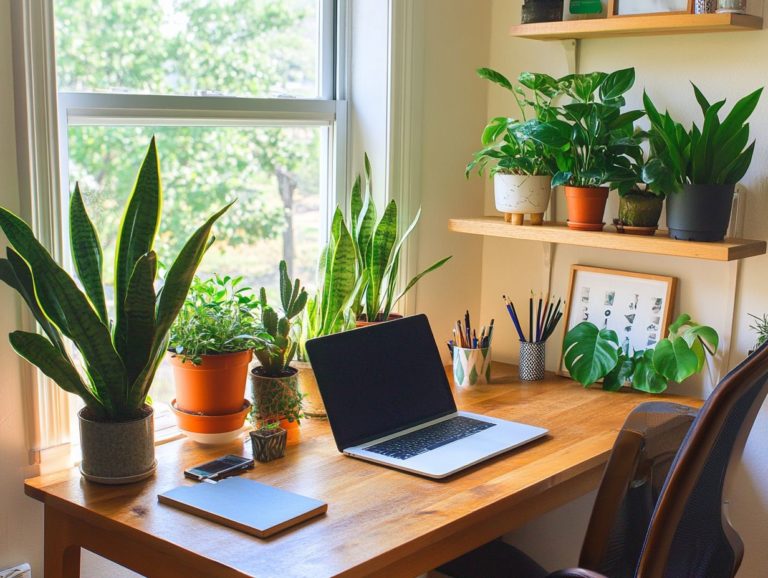How Often Should I Fertilize My Indoor Plants?
Unlocking the secrets of plant nutrition is your key to thriving indoor gardens. Understanding plant nutrition is essential for anyone aspiring to cultivate healthy houseplants.
The right balance of key nutrients is critical for their growth and vitality. Properly fertilizing your houseplants not only enhances their appearance but also supports their overall health and productivity.
By familiarizing yourself with key nutrients large nutrients and small nutrients you can make informed choices in your plant care routine. Large nutrients, like nitrogen and phosphorus, are needed in larger amounts, while small nutrients, like iron and zinc, are needed in smaller amounts. This ensures your houseplants receive the elements they need to truly thrive.
Using organic fertilizers promotes sustainable gardening practices, including homemade fertilizer, and enriches the soil composition. This creates a harmonious environment for your plants to flourish.
Contents
- Factors Affecting Fertilization Frequency
- Key Takeaways:
- Understanding Plant Nutrition
- Type of Plant and Soil
- Environmental Factors
- Signs of Nutrient Deficiency
- Determining the Right Fertilization Schedule
- Choosing the Right Fertilizer
- Fertilization Techniques for Indoor Plants
- Frequently Asked Questions
- How often should I fertilize my indoor plants?
- What happens if I fertilize my indoor plants too often?
- Can I use the same fertilizer for all of my indoor plants?
- How do I know when my indoor plants need to be fertilized?
- Can I fertilize my indoor plants during the winter?
- Are there any alternatives to chemical fertilizers for indoor plants?
The Role of Fertilizers in Plant Growth
Fertilizers are essential for the growth and development of your houseplants, supplying key nutrients that may be lacking in the soil. These nutrients such as nitrogen, phosphorus, and potassium are vital for achieving robust foliage, vibrant blooms, and healthy root systems.
Fertilizers boost nutrient availability and help create a balanced environment that allows your plants to efficiently absorb what they need. For example, organic fertilizers sourced from natural materials enhance soil structure and encourage beneficial microbial activity. Synthetic options, which are artificially made fertilizers, offer rapid nutrient release tailored to specific growth stages.
By grasping how different types of fertilizer impact nutrient balance, you can make informed choices that will help your houseplants thrive, ensuring they flourish beautifully throughout the year.
Factors Affecting Fertilization Frequency
Understanding the nuances of fertilization frequency for your houseplants is vital for their optimal care. Each houseplant has unique nutrient needs that depend on specific growth conditions and environmental factors.
For example, succulents and cacti typically require less frequent fertilization than their leafy counterparts, which flourish with regular nutrient applications of organic fertilizers or a diluted fertilizer.
Elements such as soil composition, pot size, and seasonal changes significantly impact when and how you should apply fertilizer. By mastering these variables, you can ensure your plants receive the right nutrients precisely when they need them.
Key Takeaways:
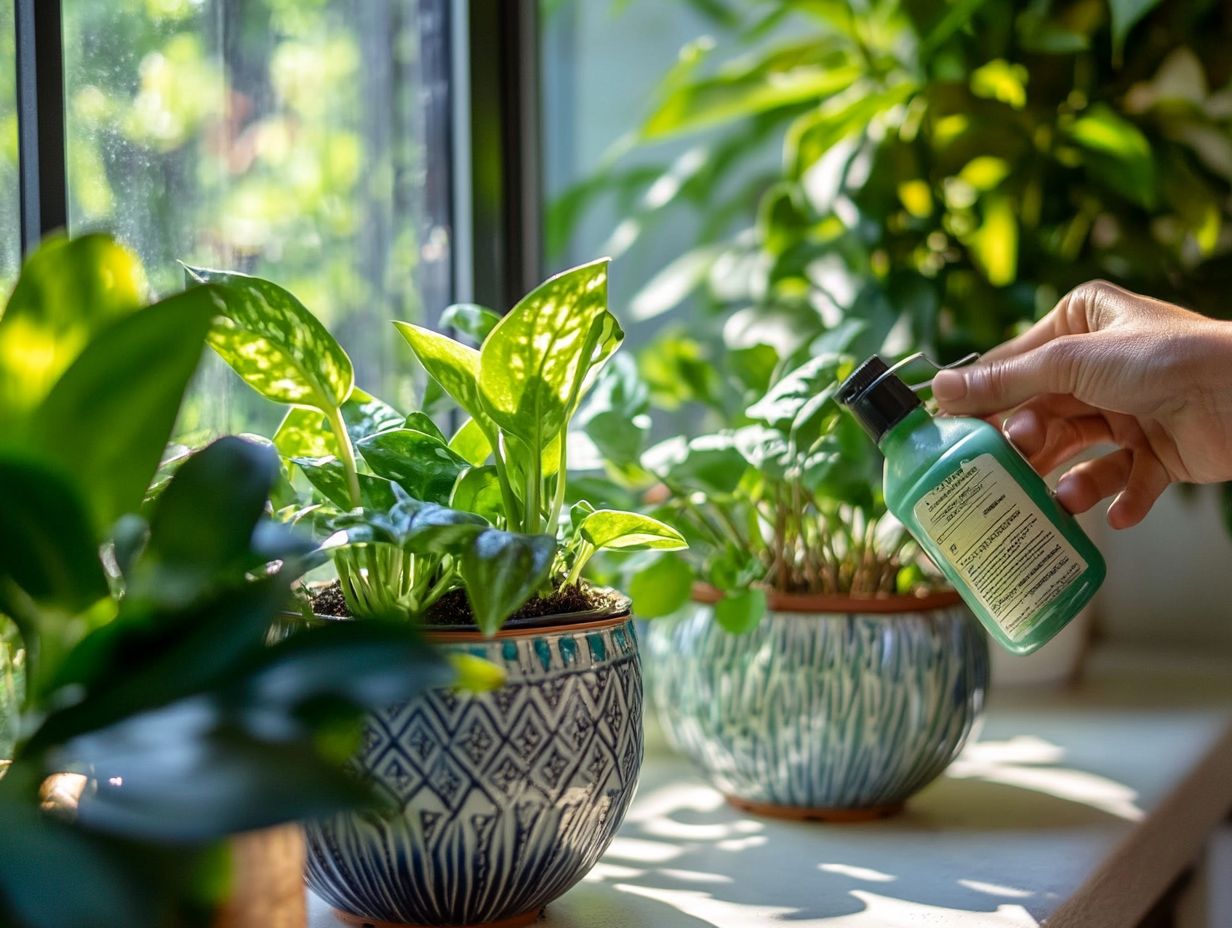
- Fertilize regularly for healthier indoor plants!
- The frequency of fertilization depends on plant type, soil quality, and environmental conditions.
- Identify nutrient deficiency symptoms and follow guidelines to determine the best fertilization schedule and fertilizer type.
Understanding Plant Nutrition
Type of Plant and Soil
The type of plant you have and its specific soil conditions are crucial for your fertilization strategy for houseplants. Each species has unique nutrient requirements and absorption capabilities.
Take succulents like aloe vera. They thrive in sandy, well-draining soils and need minimal fertilization, often thriving on diluted fertilizer during the growing season. In contrast, tropical plants like pothos or peace lilies flourish in richer soils that retain moisture and require regular feeding to support their vigorous growth.
When dealing with clay soils, it can get tricky. They often lead to nutrient loss and increase the risk of over-fertilization, which can hinder proper nutrient absorption. By closely observing your plants and their soil, you can develop a tailored fertilization schedule.
This approach will help you avoid over-fertilizing while maximizing the vitality of your houseplants.
Environmental Factors
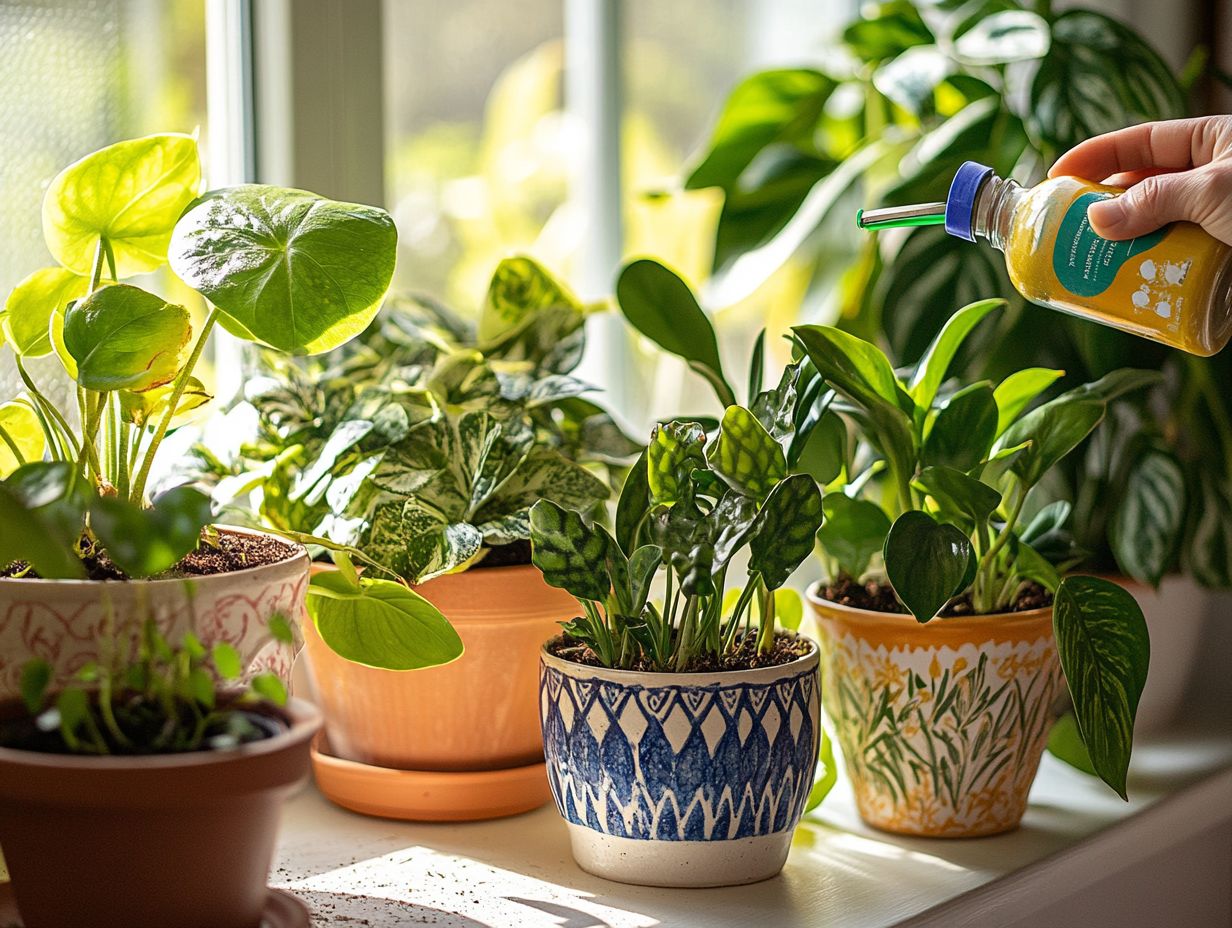
Environmental factors like light, humidity, and temperature significantly influence your houseplants’ nutrient needs, dictating how and when to apply fertilizers.
If you have a houseplant thriving in a warm, humid environment, it might show rapid growth during the growing season, making a regular fertilization schedule essential. Plants in cooler, drier conditions slow down their growth, leading to a need for less frequent nutrient input.
By understanding these nuances, you can customize your fertilization regimen to ensure each plant gets precisely what it needs to thrive.
Carefully observing growth patterns in relation to changing environmental conditions will lead to healthier, more vibrant houseplants, enriching your gardening experience.
Signs of Nutrient Deficiency
Identifying signs of nutrient deficiency in houseplants is key to maintaining their optimal health and effective fertilization practices. Symptoms like yellowing leaves, stunted growth, or browning leaf tips can signal specific deficiencies, prompting you to adjust your fertilizing strategies.
Spotting these symptoms quickly lets you act fast, delivering the necessary nutrients to restore balance and vitality to your plants.
Identifying Symptoms in Indoor Plants
<pRecognizing symptoms of nutrient deficiency is crucial for effective care. Different symptoms can indicate specific deficiencies. For example, yellowing leaves suggest a nitrogen deficiency, while leaf drop might indicate a lack of potassium or phosphorus.
Curling or browning leaf edges may indicate a calcium deficiency, and stunted growth could be due to magnesium deficiency. Each symptom is a valuable clue, emphasizing the importance of monitoring your houseplants’ health. For instance, yellowing between leaf veins, known as chlorosis, often points to iron deficiency, especially in younger leaves.
To restore balance, consider these options:
- Soil amendments
- Liquid fertilizers
- Adjusting your watering techniques
For the best results, conduct regular soil tests to pinpoint nutrient levels, guiding your houseplant care routine with precision.
Want to see your plants thrive? Start monitoring their health today!
Determining the Right Fertilization Schedule
Determining the ideal fertilization schedule for your houseplants is crucial for fostering their healthy growth and development. Different houseplants have distinct nutrient requirements that vary throughout the year.
Seasonal changes can significantly affect how and when you should apply fertilizer. For instance, many houseplants thrive with increased feeding during their active growing seasons in spring and summer, while others may need less attention during their dormant months with reduced fertilization.
Understanding the specific needs of your plants is essential. This knowledge helps you create a fertilization schedule that aligns with their unique growth patterns.
Guidelines for Different Types of Plants
Establishing guidelines for fertilizing various types of houseplants is crucial for effective care. Each species comes with its own unique nutrient requirements and growth habits.
For example, flowering plants typically thrive on balanced fertilizers with elevated phosphorus levels to promote blooming. In contrast, foliage plants often benefit from nitrogen-rich formulations that enhance leaf development.
By adhering to tailored care instructions for each plant type, you ll see the benefits of optimizing fertilization practices, leading to healthier and more vibrant houseplants.
Understanding the subtleties of each plant category further gives you the power to deliver the right nutrients at the ideal time. Cacti and succulents, for instance, flourish with fertilizers low in nitrogen, especially since their growth tends to slow down during the winter months when watering becomes less frequent.
In contrast, herbaceous perennials prefer organic fertilizers that release nutrients slowly, providing consistent feeding throughout the growing season. Meanwhile, moisture-loving plants tend to appreciate liquid fertilizers during their active growth phases.
By recognizing these specific preferences and adjusting your fertilization schedules accordingly, you re more likely to cultivate lush environments and encourage vigorous growth in your houseplants.
Choosing the Right Fertilizer
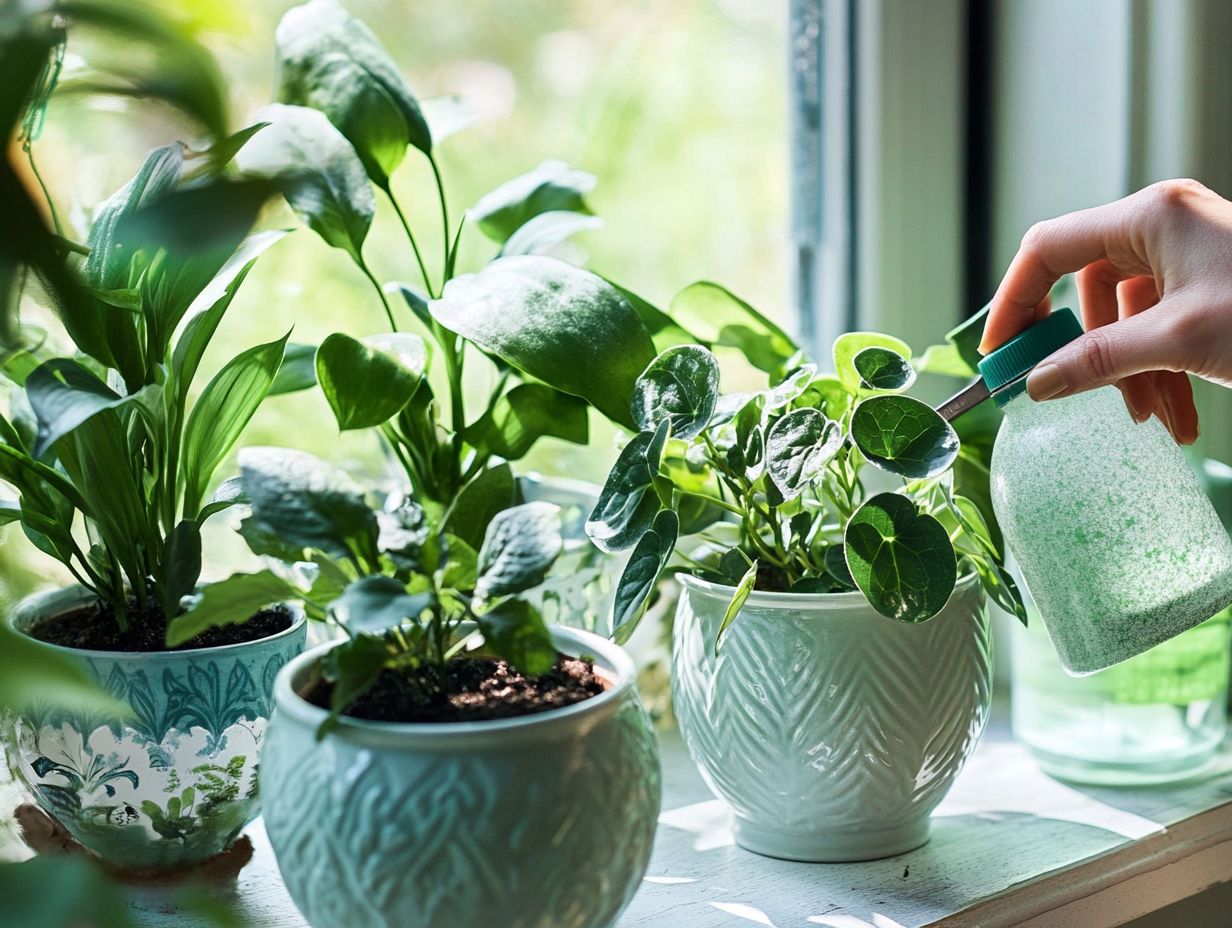
Selecting the right fertilizer for your houseplants is a vital decision that profoundly influences their growth and overall health. Each type of fertilizer brings distinct benefits and nutrient content to the table.
For example, organic fertilizers offer a gradual release of nutrients and enhance soil health, fostering a thriving environment for your plants. On the other hand, synthetic fertilizers provide immediate nutrient availability, catering to the diverse needs of various plant species.
By grasping the nuances between these options, you empower yourself to make informed choices that align seamlessly with your specific plant care objectives.
Types of Fertilizers and Their Benefits
Understanding the various types of fertilizers available is crucial for your plant care strategy. Each option brings unique benefits tailored to your gardening needs.
Organic fertilizers not only provide essential nutrients but also enhance soil structure. Conversely, synthetic fertilizers typically feature a precise N-P-K ratio, delivering immediate nutrient availability for those bursts of rapid plant growth.
If you re eager to stimulate quick nutrient uptake, liquid fertilizers are perfect for you, especially during the growing season. Slow-release fertilizers offer a steady stream of nutrients over an extended period, meaning you won’t have to apply them as frequently while still maintaining balanced nutrient levels.
The N-P-K ratio representing nitrogen, phosphorus, and potassium is essential when choosing the right fertilizer. Understanding how each component impacts plant health helps maintain vibrant foliage, robust root systems, and boosts bloom production, ensuring every houseplant reaches its full potential.
Fertilization Techniques for Indoor Plants
Implementing effective fertilization techniques for your indoor plants is essential for preserving their health and fostering optimal growth. You have a range of methods at your disposal for applying fertilizer.
Using water-soluble fertilizers seamlessly integrates into your regular watering routine, making it simple and efficient. Crafting homemade fertilizers allows you to tailor the nutrients specifically to your plants needs.
By mastering these techniques, you enhance the overall care of your indoor garden, ensuring your plants receive the vital nourishment they require to thrive throughout their life cycle.
Best Practices for Applying Fertilizer
Applying fertilizer correctly is essential for the health of your houseplants. Understanding best practices will guide you in terms of timing, method, and dilution of fertilizers.
Timing plays a pivotal role. Many houseplant enthusiasts recommend feeding during the growing season typically spring and summer when your plants are most active. To ensure your plants thrive, it’s also important to know how often to water indoor plants. This strategy maximizes nutrient uptake, enabling your plants to truly flourish.
Be cautious; over-fertilizing can lead to excess salts in the soil, which stunts growth and can inflict damage on the roots. Pay close attention to how your plants respond after fertilizing, and remember to flush the soil periodically with water.
Keep an eye out for signs of nutrient deficiency, like yellowing leaves or stunted growth. This vigilance allows you to adjust your fertilizer practices accordingly, ensuring that your indoor garden thrives beautifully.
Frequently Asked Questions
How often should I fertilize my indoor plants?
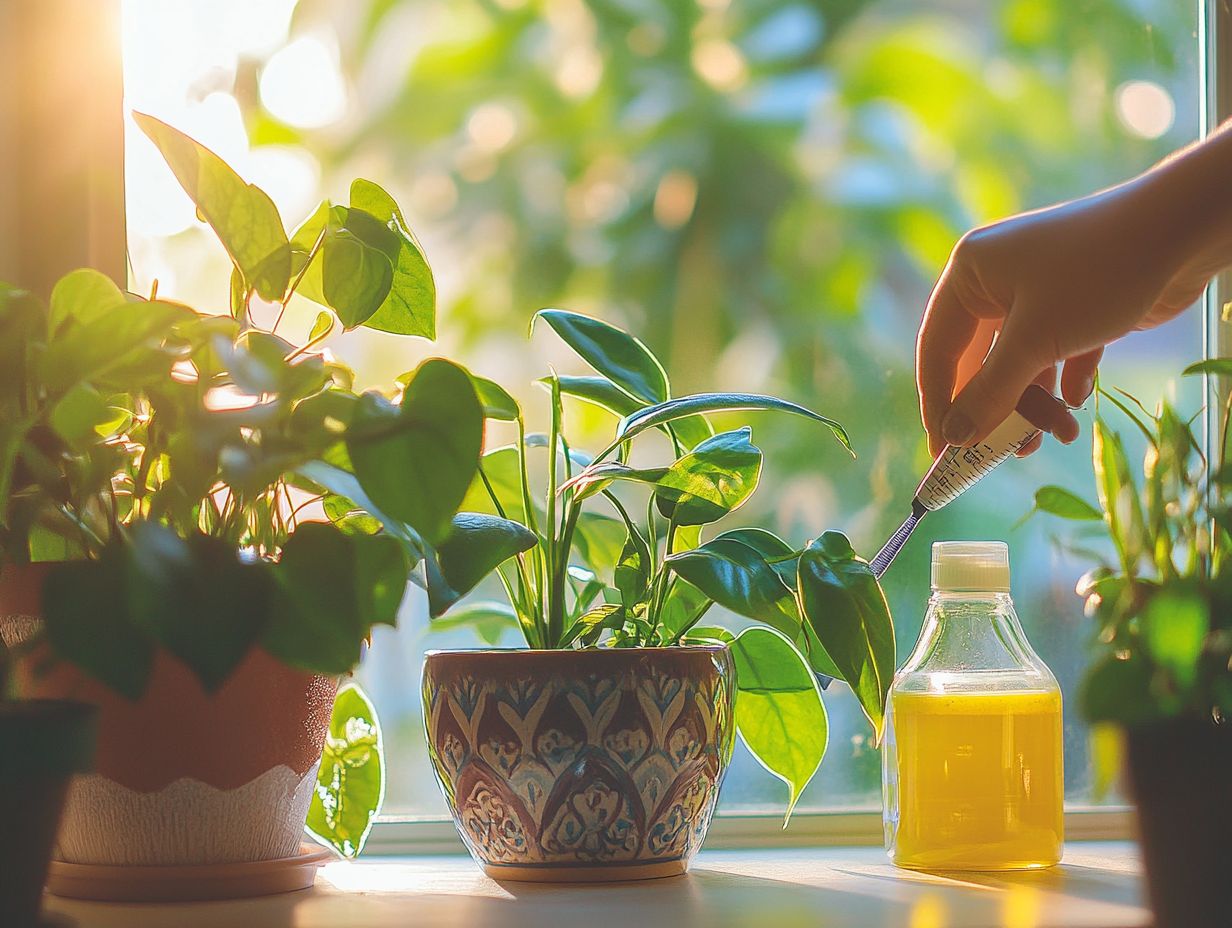
The frequency of fertilizing indoor plants depends on several factors, such as the type of plant, its growth stage, and the type of fertilizer being used. Generally, it is recommended to fertilize once every 2-3 weeks during the growing season.
What happens if I fertilize my indoor plants too often?
Over-fertilizing can lead to a buildup of salts in the soil, which can burn the roots of plants. This can result in stunted growth, yellowing leaves, and even plant death. It is important to follow the recommended fertilization schedule for your specific plants.
Can I use the same fertilizer for all of my indoor plants?
No, different plants have different nutrient requirements. It is best to use a fertilizer specifically formulated for indoor plants or choose a fertilizer based on the specific needs of your plants. This approach ensures that your plants get the right nutrients they need.
How do I know when my indoor plants need to be fertilized?
If your plants are showing signs of slow growth, pale or yellowing leaves, or if they have been in the same soil for more than 6 months, it may be time to fertilize. You can also perform a soil test to determine the nutrient levels and adjust your fertilizing schedule accordingly.
Can I fertilize my indoor plants during the winter?
In general, plants do not need as much fertilization during the winter months when they are in a dormant state. However, if your plants are actively growing or if your home has consistent temperature and lighting, you may still need to fertilize during the winter. Check the specific needs of your plants for more accurate guidelines.
Are there any alternatives to chemical fertilizers for indoor plants?
Yes, there are natural and organic fertilizers available for indoor plants, such as compost, worm castings, and fish emulsion. These alternatives can provide essential nutrients to your plants without the use of chemicals. Be sure to follow the instructions on the packaging for proper application.
Start exploring these fertilization techniques today, and watch your plants thrive!

